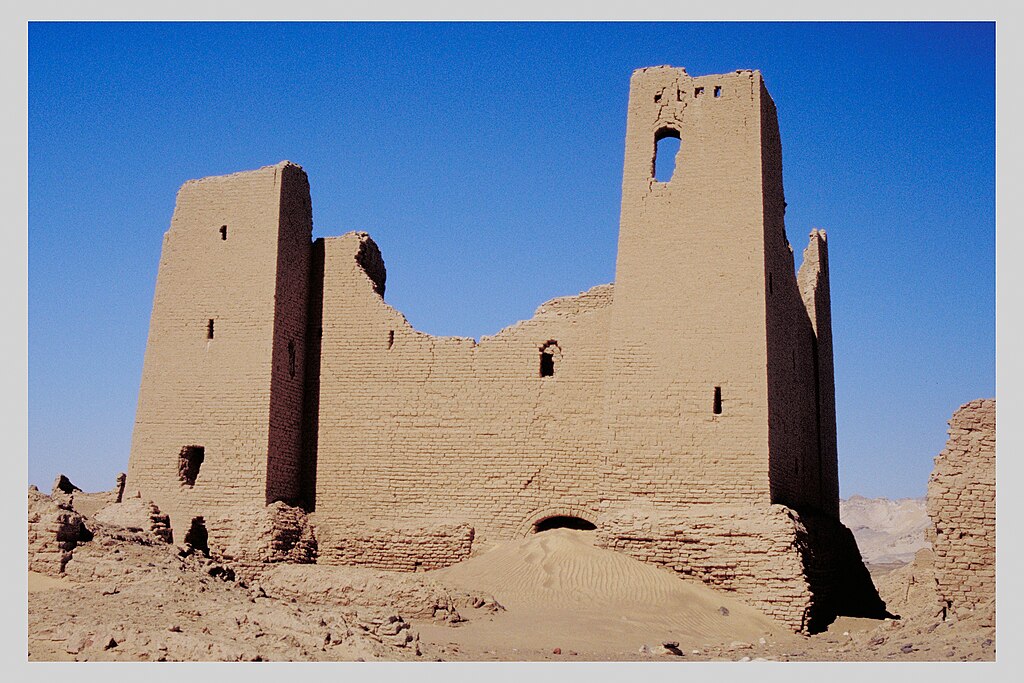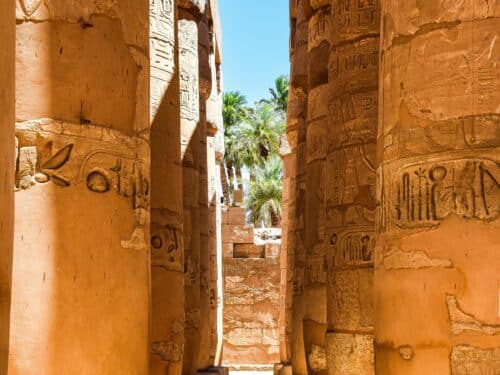

Explore Kharga Oasis, the largest oasis and historic administrative capital. Discover Roman fortresses, the stunning Temple of Hibis, and the massive Christian necropolis of Al-Bagawat. Book your profound historical journey with My Egypt Travel.
🗺️ Kharga: The Sentinel of the Desert Roads

Kharga Oasis is the largest and most significant of Egypt’s Western Desert oases, historically serving as the primary administrative and commercial hub of the region. Located nearly 200 kilometers west of Luxor, Kharga was the strategic terminus of the notorious Darb al-Arbain (Forty Days Road), a major Saharan trade route that linked Egypt with Central Africa for centuries.
For the American and European traveler, Kharga offers a powerful narrative of resilience, trade, and the surprising depth of early Christian and Roman life in the desert. It is a destination where you can trace the footprints of camel caravans, explore massive Roman forts, and witness some of the world’s oldest Christian art. This non-conventional guide, brought to you by My Egypt Travel, explores Kharga as the desert’s capital—the historical and administrative backbone of the oases.
The Crossroads of History: A Non-Conventional Perspective
Kharga’s essence is its role as a crossroads. It sits at the intersection of three major historical forces: Pharaonic religion, Roman military logistics, and the spread of early Christianity. Unlike the focus on tombs in Luxor or art in Farafra, Kharga’s monuments speak of organization, control, and faith. Our tours emphasize the strategic significance of the region, revealing how the desert was managed and defended.
I. Roman Fortifications: The Military Grid
The Romans heavily utilized Kharga as a garrison to control the desert routes and protect vital agricultural resources. The remains of their massive mud-brick fortresses are a major draw.
1. Qasr El-Ghueita (The Temple Fortress)
This site features a well-preserved Roman-era temple built upon Pharaonic foundations. The entire complex was later enclosed within a massive mud-brick wall by the Romans, transforming it into a formidable fortress.
- Unique Feature: The temple remains one of the few places in Egypt dedicated to the goddess Mut and the unique Kharga Triad (Amun, Mut, and Khonsu).
2. Qasr Zayyan (The Water Control)
This Roman site features the ruins of a temple dedicated to Amun and contains remnants of the ancient irrigation and water distribution systems, underscoring the vital importance of water management to Roman control.
3. Labyrinthine Roman Fortresses
Scattered throughout the oasis are the remains of other major Roman forts, such as Dush (near the southern tip), which controlled the entry point of the Darb al-Arbain trade route. These sites offer a tangible connection to the vast military and economic reach of the Roman Empire in the Sahara.
II. The Pharaonic and Hellenistic Legacy
Despite the heavy Roman presence, Kharga’s deepest historical roots lie in the Pharaonic and Persian periods.
4. The Temple of Hibis (The Persian Gem)
The Temple of Hibis is the largest and best-preserved temple in the Kharga Oasis. Its significance lies in its dating: it was built during the Persian occupation of Egypt (26th Dynasty), making it a rare example of temple architecture from that era.
- Architectural Detail: The temple features intricate reliefs and inscriptions dedicated to Amun, showcasing a fascinating stylistic fusion of Persian influences with traditional Egyptian temple design. It is a must-see for archaeological purists.
5. Nadura Temple
Located north of the city, this Ptolemaic-Roman temple provides stunning panoramic views of the entire oasis depression, emphasizing Kharga’s vast, fertile scale.
III. The Early Christian Narrative: Al-Bagawat
Kharga is arguably the most important site in Egypt for witnessing the architectural and artistic remnants of early Christianity and the monastic movement.
6. The Necropolis of Al-Bagawat (The Christian City of the Dead)
This large, well-preserved early Christian cemetery (dating from the 4th to 7th centuries AD) is a stunning site featuring hundreds of mud-brick domed tombs (cupola chapels).
- Artistic Significance: Several tombs contain exceptionally rare, vivid frescoes depicting biblical scenes—including Adam and Eve, Noah’s Ark, and key New Testament figures—which are some of the oldest Christian paintings in the world. This is a unique feature highly attractive to Western audiences.
- Non-Conventional Insight: Visiting Al-Bagawat offers a profound look at the transition from paganism to Christianity in a remote desert setting, highlighting the deep religious history of Egypt.
IV. The Modern Pulse and Logistics

As the modern capital of the New Valley Governorate, Kharga is the most developed and logistically crucial of the oases.
7. Local Culture and Cuisine
While not as immediately picturesque as Farafra, Kharga offers genuine local culture and a robust local market (souq). The date palms and olive groves continue to define the area’s agricultural base.
8. The Kharga Museum
This museum houses the major archaeological finds from the entire oasis, including Pharaonic statues, Roman coins, and Coptic artifacts, providing excellent historical context before visiting the remote sites.
V. Planning Your Historical Expedition with My Egypt Travel

A visit to Kharga provides depth and historical complexity, making it an ideal anchor for a Western Desert itinerary.
Seamless Desert Touring
- Expert Routing: Due to the wide dispersal of its sites, Kharga demands efficient routing. My Egypt Travel structures the tour to logically link the temples (Hibis), the early Christian site (Al-Bagawat), and the Roman forts (Dush), minimizing travel time.
- The Trade Route Connection: We emphasize Kharga’s connection to the Darb al-Arbain, often using the desert roads for our transfers to recreate a sense of the ancient trade caravans, enhancing the “adventure” aspect.
Comfort and Accessibility
As the most developed oasis, Kharga offers modern accommodations, which are utilized to ensure traveler comfort before and after the more rugged excursions into the surrounding desert. We ensure all logistics—from transportation to accommodation—are of the highest standard.
🔑 Conclusion: The Enduring Legacy of Kharga
Kharga Oasis is a powerful destination that tells a story of enduring civilization at the edge of the known world. It reveals the Roman military grip, the spiritual fervor of early Christianity, and the sheer scale of ancient trade. It is the place to discover the strategic depth and multi-layered history of Egypt’s great Western Desert.
Ready to trace the ancient caravan routes and explore the surprising birthplace of desert Christianity? Let My Egypt Travel guide your profound historical journey to the Kharga Oasis.




